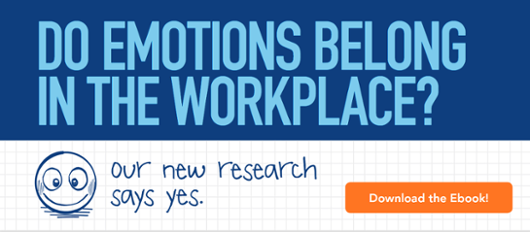Emotions in the Workplace: How to Deal With Emotions at Work

Almost everything we do relates to emotions, even at work.
Did you laugh or smile at work today? Were you bored in your last meeting? Upset or sad about losing a customer? Excited about hitting a goal? These are all examples of the many emotional moments that occur in the workplace each day.
To offer insights into the variety and complexity of emotions at work, we conducted a research study to understand employee emotions and how they relate to employee engagement at work.
In this blog, we’ll cover everything you need to know to understand and manage emotions in the workplace, including:
- The most common emotions at work
- How emotions differ throughout the organization
- The relationship between emotions and employee engagement
- How to manage emotions in the workplace
The most common emotions at work
To create awesome emotional cultures, organizations need to understand which emotions are prevalent in the workplace and how they affect employees.
Here are the most common positive and negative emotions at work:
- Comfortable
- Satisfied
- Enthusiastic
- Frustrated
- Stressed
- Anxious
Positive emotions at work
Positive emotions aren’t limited to only optimistic and hopeful feelings. Examples of positive emotions could include calm, comfortable, energetic, enthusiastic, excited, happy, joyful, peaceful, relaxed, and satisfied.
Our research found that the top three positive emotions felt by employees at work are:
- Comfortable (47.8%)
- Satisfied (37.1%)
- Enthusiastic (36.6%)
Negative emotions at work
There are a lot of negative emotions that can surface at work. Examples of negative emotions could include annoyed, anxious, bored, disinterested, dissatisfied, frustrated, gloomy, miserable, sad, stressed, tired, uncomfortable, unhappy, upset, and worried.
Here's what employees identified as the top three negative emotions felt at work:
- Frustrated (56.2%)
- Stressed (45.1%)
- Anxious (30.4%)
Negative moral emotions at work
Basic emotions like happiness and sadness are pretty straightforward and easy to understand. But many of the emotions we experience in the workplace are much more complex—especially moral emotions.
Morals are the principles that differentiate between good and bad behavior, and they vary from person to person. Emotions that are influenced by our morals are called moral emotions. They include emotions like guilt, regret, and shame—and they carry much more weight than our primary emotions.
When taking average rank and top 3 percentage into account, employees believe the most negative moral emotions are:
- Humiliation
- Disgust
- Resentment
How emotions differ throughout the organization
There’s a lot that can contribute to both negative and positive emotions at work. Many factors occur in our personal and professional lives, but what about things like tenure and position level?
Individual contributors may feel frustrated from a lack of support or satisfied when they receive a promotion.
Managers may feel stressed from conducting many 1:1s or comfortable with the progress their team has made.
Leaders may feel anxious about the forecast of their business or enthusiastic about starting the year fresh with a brand new focus.
We are all capable of feeling a variety of emotions at work. Yet, our research uncovered some differences between individual contributors and managers.
Managers are more likely to feel energetic, enthusiastic, and happy—but managers likely feel comfortable less often.There are many factors that contribute to our emotions. Managers may tend to feel positive emotions more often due to their roles as coaches. At the same time, managers often have more responsibilities and encounter more barriers than individual contributors. This could explain a higher frequency of stress.
The relationship between emotions and employee engagement
For some, emotions can take a toll on our day. Some may disengage from their work and some may miss work altogether. Our research shows some clear connections between emotional culture and levels of engagement. Engagement impacts a wide variety of important business outcomes—making a solid case for addressing emotions at work.
Burying emotions hurts engagement, but so does being in a toxic environment. When the people around you are frequently and openly expressing negative emotions, it can have a damaging effect on employee engagement.
Employee engagement and negative emotions
Experiencing negative emotions expressed by others may decrease feelings of connection. As employee engagement decreases, employees may become more sensitive to negative emotions.
To help decrease the expression of negative emotions at work, you need to understand what happened before those emotions boiled over. Each type of emotion is unique and requires a unique approach to handling it.
Employee engagement and emotional outcomes
In theory, highly engaged employees are more open-minded when it comes to potential outcomes of negative emotions. Yet, they are more close-minded when it comes to potential outcomes of positive emotions.
On one hand, engagement is a negativity filter. At the same time, it promotes positivity bias. Bottom line—highly engaged employees are more positive than less engaged employees.
But it’s also possible that disengaged employees have a harder time coping with emotions in healthy ways. Consider evolving your approach to disengaged employees by viewing them through the lens of reconnection. Help them strengthen their coping mechanisms to handle stress at work.
How to manage emotions in the workplace
When left unchecked, employee emotions can have a serious impact on the workplace. Make sure you understand each of these unique emotions and strive to find the right balance of supporting and preventing them at work.
Building a culture of trust and practicing emotional intelligence skills can allow employees to acknowledge, feel, and express more positive emotions in the workplace. Here are some ways to manage emotions in the workplace.
Coping mechanisms for employee emotions
Coping mechanisms are the tools and strategies we use to deal with stress in our lives. Our various ways of coping eventually create a coping strategy.
You can cope with stress in positive or negative ways. A negative coping strategy might be to ignore your problems and emotions, hoping they work themselves out. But that can be bad for your health. Positive coping strategies allow you to deal with stress in healthy ways.
Managing your own emotions
The best thing you can do to combat negative moral emotions and their repercussions is understand how to deal with emotions. Take the Recognize, Understand, Manage approach when dealing with emotions at work.
Recognize
When emotions start to bubble up, don't panic. Take a deep breath and recognize the emotion for what it is. Don't react immediately. Instead try to put a label on what it is you're feeling. Determine when you became aware of the feeling and what triggered it. Don't judge yourself for how you feel.
Understand
After you've named your emotions, focus on the "why" behind them. Dig deep and try to discover their origin. Follow them down the pathway to where you are now with questions like these:
- If you feel upset, what is causing you to feel that way?
- Are your emotions coming from something within you, or something external?
If it's a familiar emotion, think about other times you've felt this emotion and how you previously responded.
- What went well?
- What didn't?
- How do you want to respond differently in this moment?
Manage
Once you've taken time to cool down and reflect, the third and final step is managing the situation. You need to figure out how you are going to respond, if at all. There are no hard and fast rules for how to respond, but here a few things to consider:
- Do you still feel the need to address the situation?
- Is it possible you overreacted?
- Are there things that need to be resolved before you can move forward?
- What will you say when you do address the situation? What might others involved say?
- What did you learn from this situation that you can apply to future situations like it?
Dealing with employee emotions: 4 tips for leaders
Regardless of how well you handle your own emotions, you can’t control the emotions of others. But it is important to learn how to acknowledge them and respond appropriately. Unresolved issues can lead to decreased productivity, damaged relationships, and lowered engagement.
Follow these tips for dealing with your employees’ emotions and start building a stronger emotional culture at work:
1. Allow for mistakes.
No one is perfect—plain and simple. Mistakes are inevitable and, although they don’t need to be simply accepted, they also aren’t grounds for a scolding. Berating or punishing employees can cause humiliation and hostility.
Calmly correcting or excusing the rare mistake is a great way to build trust. In fact, helping reduce negative emotions with transparency, open communication, and authenticity will lead to better relationships with your employees. But if mistakes continue to pile up, you should schedule time with your employees to create a performance improvement plan. This plan will help make sure both parties are on the same page and set clear expectations for success.
2. Build a culture of trust.
Sharing emotions, especially uncomfortable ones, is one way to show vulnerability. But we can’t be vulnerable if we don’t trust the people that we’re sharing our stories with. Everyone in your organization should feel comfortable being themselves and expressing their emotions.
It’s not enough just to let employees know they can share their feelings—you must be willing to be the example too. When employees can witness a culture of honesty and compassion, they’ll be able to understand and adapt to others’ emotions.
3. Be present.
When managers and leaders are unavailable, employees may feel anxious and undervalued. Make time to connect with your team to instill confidence in your employees, their work, and their performance. Empowering your team members to stay connected in this way helps build positive relationships.
Set uninterrupted time apart for each employee at least once a month. And if you're really committed to the cause, we recommend meeting once a week—even for a quick check-in. These meetings offer employees an opportunity to ask questions, provide updates, raise concerns, and provide feedback. These are perfect times to celebrate successes to increase positive emotions in the workplace.
4. Listen more than you talk.
Most times, employees who experience negative emotions aren’t searching for solutions. They want to express themselves and release their pent-up emotions. Listening to your employees allows them to get it all out there and makes them feel cared for and heard. It also establishes you as a trusted resource who can be depended on.
When dealing with someone else's emotions, strive to understand what they are feeling and why. Ask them how they are feeling and if they are okay. If they don't want to talk or say everything is fine, respect their wishes and don't pressure them any further. If they do want to talk it out, find a quiet space and listen.
Your employees are only human, and humans are emotional creatures. Addressing emotions is important for recognizing your employees for who they are and improving your emotional culture.
Understanding and managing the emotions of your employees at work is only the first step. Use these tips to guide your engagement efforts and bring humanity back to the workplace. Get your copy of our ebook, Emotions in the Workplace, for more data and insights.







